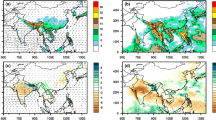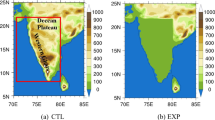Abstract
Interactions between midlatitude disturbances and the monsoonal circulation are significant for the Indian summer monsoon (ISM) rainfall. This paper presents examples of monsoon–midlatitude linkage through anticyclonic Rossby wave breaking (RWB) over West Asia during June, July and August of the years 1998–2010. RWB events over West Asia are identified by the inversion of the potential vorticity air mass at three different isentropic levels (340, 350, and 360 K) using daily NCEP–NCAR reanalysis. It is observed that RWB took place over West Asia before/during breaks in the ISM. Further, these events occur on the anticyclonic shear side of the subtropical jet, where the gradient of the zonal wind is found to be high. RWB is responsible for the southward movement of high potential vorticity air from the westerly jet, leading to the formation of a blocking high over the Arabian region. In turn, this blocking high advects and causes the descent of upper tropospheric cold and dry air towards Central India. Such an air mass with low moist static energy inhibits deep monsoonal convection and thereby leads to a dry spell. In fact, we find that RWB induced blocking over West Asia to be one of the major causes of dry spell/break episodes in ISM. Additionally, the presence of cold air over Central India reduces the north–south thermal contrast over the monsoon region thereby modifying the local Hadley circulation over the region.












Similar content being viewed by others
References
Abatzoglou JT, Magnusdottir G (2006) Planetary wave breaking and nonlinear reflection: seasonal cycle and interannual variability. J Clim 19:6139–6152
Allen G, Vaughn G, Brunner D, May PT, Heyes W, Minnis P, Ayers JK (2009) Modulation of tropical convection by breaking Rossby waves. Q J R Meteorol Soc 135:125–137. doi:10.1002/qj.349
Annamalai H, Slingo JM (2001) Active/break cycles: diagnosis of the intraseasonal variability of the Asian summer monsoon. Clim Dyn 18:85–102
Ashok K, Guan Z, Saji NH, Yamagata T (2004) Individual and combined influences of ENSO and the Indian Ocean Dipole on the Indian summer monsoon. J Clim 17:3141–3155. doi:10.1175/1520-0442(2004)017<3141:IACIOE>2.0.CO;2
Ashok K, Behera SK, Rao SA, Weng H, Yamagata T (2007) El Nino Modoki and its possible teleconnection. J Geophys Res. doi:10.1029/2006JC003798
Barlow M, Wheeler M, Lyon B, Cullen H (2005) Modulation of daily precipitation over southwest Asia by the Madden–Julian oscillation. Mon Weather Rev 133(12):3579–3594
Barnes EA, Hartmann DL (2012) Detection of Rossby wave breaking and its response to shifts of the midlatitude jet with climate change. J Geophys Res 117:D09117. doi:10.1029/2012JD017469
Bhat GS (2006) The Indian drought of 2002—a subseasonal phenomenon? Q J R Meteorol Soc 132:2583–2602
Bordoni S, Schnrider T (2008) Monsoon as eddy mediated regime transitions of the tropical overturning circulation. Nat Geosci 1(18):515–519. doi:10.1038/ngeo248
Cau P, Methven J, Hoskins BJ (2005) Representation of dry tropical layers and their origins in ERA-40 data. J Geophys Res. doi:10.1029/2004JD004928
Ding Q, Wang B (2005) Circumglobal teleconnection in the Northern Hemisphere summer. J Clim 18(17):3483–3505
Ding Q, Wang B (2007) Intraseasonal teleconnection between the summer Eurasian wave train and the Indian monsoon. J Clim 20(15):2751–2767. doi:10.1175/JCLI4221.1
Fasullo J, Webster PJ (2002) Hydrological signatures relating the Asian summer monsoon and ENSO. J Clim 15:3082–3095. doi:10.1175/1520-0442(2002)015<3082:HSRTAS>2.0.CO;2
Gadgil S (2003) The Indian monsoon and its variability. Annu Rev Earth Planet Sci 31(1):429–467
Gadgil S, Joseph PV (2003) On breaks of the Indian monsoon. Proc Indian Acad Sci (Earth Planet Sci) 112(4):529–558
Gadgil S, Vinayachandran PN, Francis PA, Gadgil S (2004) Extremes of the Indian summer monsoon rainfall, ENSO and equatorial IO oscillation. Geophys Res Lett. doi:10.1029/2004GL019733
Goswami BN (1998) Interannual variation of Indian summer monsoon in a GCM: external conditions versus internal feedbacks. J Clim 11:501–522
Goswami BN, Ajaya Mohan RS (2001) Intraseasonal oscillations and interannual variability of the Indian summer monsoon. J Clim 14:1180–1198
Goswami BN, Shukla J (1984) Quasi-periodic oscillations in a symmetric general circulation model. J Atmos Sci 41:20–37. doi:10.1175/1520-0469(1984)041<0020:QPOIAS>2.0.CO;2
Goswami BN, Xavier PK (2005) Dynamics of “internal” inter-annual variability of Indian summer monsoon in a GCM. J Geophys Res. doi:10.1029/2005JD006042
Goswami BN, Wu G, Yasunari T (2006) The annual cycle, intraseasonal oscillations, and roadblock to seasonal predictability of the Asian summer monsoon. J Clim 19:5078–5099
Hoskins BJ, McIntyre ME, Robertson AW (1985) On the use and significance of isentropic potential vorticity maps. Q J R Meteorol Soc 111:877–946. doi:10.1002/qj.49711147002
Ihara C, Kushnir Y, Cane MA, De La Peña VH (2007) Indian summer monsoon rainfall and its link with ENSO and Indian Ocean climate indices. Int J Climatol 27:179–187. doi:10.1002/joc.1394
Joseph S, Sahai AK, Goswami BN (2009) Eastward propagating MJO during boreal summer and Indian monsoon droughts. Clim Dyn 32:1139–1153. doi:10.1007/s00382-008-0412-8
Kalnay E, Kanamitsu M, Kistler R, Collins W, Deaven D, Gandin L, Iredell M, Saha S, Jenne R et al (1996) The NCEP/NCAR 40-year reanalysis project. Bull Am Meteorol Soc 77(3):437–471
Kar SC, Sugi M, Sato N (2001) Interannual variability of the Indian summer monsoon and internal variability in the JMA global model simulations. J Meteorol Soc Jpn 79(2):607–623
Krishna Kumar K, Rajagopalan B, Hoerling M, Bates G, Cane M (2006) Unravelling the mystery of Indian monsoon failure during El Niño. Science. doi:10.1126/science.1131152
Krishnamurthy V, Shukla J (2000) Intraseasonal and interannual variability of rainfall over India. J Clim 13:4366–4377. doi:10.1175/1520-0442(2000)013<0001:IAIVOR>2.0.CO;2
Krishnamurthy V, Shukla J (2007) Intraseasonal and seasonally persisting patterns of Indian monsoon rainfall. J Clim 20:3–20. doi:10.1175/JCLI3981.1
Krishnamurti TN, Thomas A, Simon A, Kumar V (2010) Desert air incursions, and overlooked aspect, for the dry spells of the Indian summer monsoon. J Atmos Sci 67:3423–3441. doi:10.1175/2010JAS3440.1
Krishnan R, Zhang C, Sugi M (2000) Dynamics of breaks in the Indian summer monsoon. J Atmos Sci 57:1354–1372. doi:10.1175/1520-0469(2000)057<1354:DOBITI>2.0.CO;2
Krishnan R, Kumar V, Sugi M, Yoshimura J (2009) Internal feedbacks from monsoon–midlatitude interactions during droughts in the Indian summer monsoon. J Atmos Sci 66:553–578. doi:10.1175/2008JAS2723.1
Lau KM, Kim MK, Kim KM (2006) Asian summer monsoon anomalies induced by aerosol direct forcing: the role of the Tibetan Plateau. Clim Dyn 26(7–8):855–864
Masato G, Hoskins BJ, Woollings TJ (2012) Wave-breaking characteristics of midlatitude blocking. Q J R Meteorol Soc 138:1285–1296. doi:10.1002/qj.990
McIntyre ME, Palmer TN (1985) A note on the general concept of wave breaking for Rossby and gravity waves. Pure appl Geophys 123:964–975
Neena JM, Suhas E, Goswami BN (2011) Leading role of internal dynamics in the 2009 Indian summer monsoon drought. J Geophys Res. doi:10.1029/2010JD015328
Pelly JL, Hoskins BJ (2003) A new perspective on blocking. J Atmos Sci 60:743–755. doi:10.1175/1520-0469(2003)060<0743:ANPOB>2.0.CO;2
Postel GA, Hitchman H (1999) A climatology of Rossby wave breaking along the subtropical tropopause. J Atmos Sci 56:359–373
Rajeevan M, Gadgil S, Bhate J (2010) Active and break spells of the Indian summer monsoon. J Earth Syst Sci 119(3):229–247
Rajeevan M, Rohini P, Niranjan Kumar K, Srinivasan J, Unnikrishnan CK (2013) A study of vertical cloud structure of the Indian summer monsoon using CloudSat data. Clim Dyn 40:637–650. doi:10.1007/s00382-012-1374-4
Ramamurthy K (1969) Monsoon of India: some aspects of the ‘Break’ in the Indian southwest monsoon during July and August. Forecasting Manual IV 18(3):1–57 India Met Dept, Pune, India
Raman CRV, Rao YP (1981) Blocking highs over Asia and monsoon droughts over India. Nature 289:271–273
Ramaswamy C (1962) Breaks in the Indian summer monsoon as a phenomenon of interaction between the easterly and the sub-tropical westerly jet streams. Tellus 14(3):337–349. doi:10.1111/j.2153-3490.1962.tb01346.x
Ramesh Kumar MR, Prabhu Dessai UR (2004) A new criterion for identifying breaks in monsoon conditions over the Indian subcontinent. Geophys Res Lett. doi:10.1029/2004GL020562
Saji NH, Goswami BN, Vinayachandran PN, Yamagata T (1999) A dipole mode in the tropical Indian Ocean. Nature 401:360–363
Samanta D, Dash MK, Pandey PC (2013) Unusual circulation pattern during Indian summer monsoon failure in July 2002 and June 2009. Nat Hazards 65(1):295–302. doi:10.1007/s11069-012-0357-4
Singh C (2013) Characteristics of monsoon breaks and intraseasonal oscillations over central India during the last half century. Atmos Res 128:120–128
Singh SV, Kripalani RH, Sikka DR (1992) Interannual variability of the Madden–Julian oscillations in Indian summer monsoon rainfall. J Clim 5:973–978. doi:10.1175/1520-0442(1992)005<0973:IVOTMJ>2.0.CO;2
Strong C, Magnusdottir G (2008) Tropospheric Rossby wave breaking and the NAO/NAM. J Atmos Sci 65:2861–2876. doi:10.1175/2008JAS2632.1
Xavier PK, Marzin C, Goswami BN (2007) An objective definition of the Indian summer monsoon season and a new perspective on the ENSO–monsoon relationship. Q J R Meteorol Soc 133:749–764. doi:10.1002/qj.45
Acknowledgments
This study was funded by the Ministry of Earth Sciences (MOES), India Government, in the frame of the project entitled ‘South Asian Precipitation: A Seamless Assessment (SAPRISE)’. Interpolated NCEP Reanalysis data provided by the NOAA/OAR/ESRL PSD, Boulder, Colorado, USA, from their web site at http://www.esrl.noaa.gov/psd. TRMM 3B42 daily precipitation data has been downloaded from NASA site. We thank both the anonymous reviewers for their constructive comments, which improved the quality of the manuscript significantly.
Author information
Authors and Affiliations
Corresponding author
Electronic supplementary material
Below is the link to the electronic supplementary material.
Rights and permissions
About this article
Cite this article
Samanta, D., Dash, M.K., Goswami, B.N. et al. Extratropical anticyclonic Rossby wave breaking and Indian summer monsoon failure. Clim Dyn 46, 1547–1562 (2016). https://doi.org/10.1007/s00382-015-2661-7
Received:
Accepted:
Published:
Issue Date:
DOI: https://doi.org/10.1007/s00382-015-2661-7




